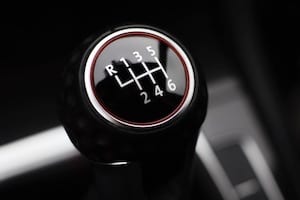When I had my first stick-shift, I was a beginner manual driver and so made the common mistakes of stalling every once in a while and revving the engine too high or not high enough. My car did not have a tachometer and it felt difficult to know when to shift at just the right moment.
And it IS tricky to learn – it requires a lot of practice! But also I was concerned with damage to my transmission. I wanted to be sure that I always shifted at the right time and didn’t rev the engine too high before shifting.
I got the hang of it rather quickly but learned from my mistakes along the way. Here are some tips to help you know when to shift especially without a tachometer. And not just for shifting in a car. Lots of motorcycles and dirt bikes and scooters do not have tachometers and all of these things apply to those as well.
1. Shift by the Sound of the Engine
Shifting at the right moment especially without a tachometer just takes practice and getting used to the feel of the vehicle. Each vehicle is a little different but after you practice some, you won’t even have to think about it.
Surprisingly, a lot of cars and bikes don’t have a tachometer. Most do, but a lot don’t. And actually even the drivers of the vehicles that DO have tachometers don’t watch them. It IS helpful to see the rpms when you are learning and getting used to the vehicle, but as soon as you have a couple hours of practice, most drivers don’t look down at the tachometer anyways.
Most drivers of manual cars know when to shift by the feel of the car and the sound of the engine. Most drivers do not look at the tachometer to know when to shift.
Shift when the car begins to whine from the engine spinning fast.
For first gear, you should not wait very long. Shift to second as soon as you can. For the rest of the gears, if you shift into the gear and hear the car stumble or sound bogged down, you shifted too soon.
Wait till the car begins to whir at a high rpm. Take your foot off the gas, press the clutch, and shift.
Shifting by Sound in Cars that are Extremely Quiet
How about for the cars that are super quiet? Most new cars that are ultra quiet have a tachometer but if for some reason you cannot hear the motor or judge very well by the noise of the engine, then you should consider adding an aftermarket tachometer that I discuss more at the end of the post.
Or try shifting by paying attention to your speed.
2. Judge the Shift Timing by Your Speed
You can generalize each gear by a speed range and shift when the car is at a certain speed. That way you can keep an eye on the speedometer if you want to have something visual to indicate when to shift.
Different vehicles are going to all behave differently and have slightly different speed ranges for the gears, but this is a general range for when to shift based on your speed.
1st Gear: 0-10 mph (0-15 km/h)
2nd Gear: 5-25 mph (10-40 km/h)
3rd Gear: 20-45 mph (30-70 km/h)
4th Gear: 30-65 mph (50-100 km/h)
5th Gear: 45 mph + (70+ km/h)
Again, each vehicle is different so what you can do is drive and start with this as a basis and make any adjustments to the speed you should shift when your car performs the best.
3.Shift by Feel
Shifting by feel is generally something that comes with a good amount of practice so if you are new to driving manual, then don’t be concerned at this point. But after 5-10 hours of practice driving manual, you will have a good enough feel of the car to know when to shift by feel.
Shift by feel by paying attention to how much the movement of the gas pedal changes the car’s speed. You will notice that as you get to high rpms and a good time to shift gears, that more movement of the gas pedal will affect the speed of the car less.
It is best to shift when this transition just begins to happen so the rpms are not too low but they are also not too high.
You will naturally get a feel for the gas pedal and will soon be able to shift just by feel.
4. Install an Aftermarket Tachometer
Yes, this is the ultra sneaky way. Shift without a tachometer – by installing a tachometer!
If you still can’t bear the idea of always driving without a tachometer, then for just a few dollars you can install one yourself.
Installing an aftermarket tachometer is VERY easy to do.
A lot of these simply clamp on, or wrap around the spark plug wire to indicate how fast the engine is firing/spinning.
You can install an aftermarket tachometer if you still feel that you would rather be able to see the rpms of the engine. Perhaps your engine is extremely quiet, or if you are hard of hearing.
There is a huge range of tachometers available that are all so simple to install.
This one on Amazon has excellent reviews, and a good price.
This one at Summit Racing is a bit more expensive but has a conventional dial and is designed for cars or motorcycles.
Tips to Keep the Shifting Smooth
A few tips as you continue to get a feel for the car and shifting without a tach!
- Take your foot off the gas pedal before shifting.
- Release the clutch slowly shifting into the new gear.
- First gear is just to get the car moving. Shift to second as soon as possible.
- Press the clutch all the way down.


